Global Research Trends on Water Contamination by Microorganisms: A Bibliometric Analysis
Abstract
1. Introduction
2. Materials and Methods
3. Results
3.1. Publication Year
3.2. Scientific Journals
3.3. Authors’ Production
3.4. Affiliate Institutions
3.5. Countries and Collaborations
3.6. Most Cited Articles
3.7. Conceptual Structure
4. Discussion
5. Limitations
6. Conclusions
Author Contributions
Funding
Institutional Review Board Statement
Informed Consent Statement
Data Availability Statement
Conflicts of Interest
References
- Raghavendra, N. Drinking Water Contamination and Its Solving Approaches: A Comprehensive Review of Current Knowledge and Future Directions. Water. Air. Soil Pollut. 2024, 235, 639. [Google Scholar] [CrossRef]
- Hile, T.D.; Dunbar, S.G.; Sinclair, R.G. Microbial Contamination Analysis of Drinking Water from Bulk Dispensers and Fast-Food Restaurants in the Eastern Coachella Valley, California. Water Supply 2023, 23, 3578–3596. [Google Scholar] [CrossRef]
- Mendoza-Espinosa, L.G.; Mojiri, A. Wastewater and Microbial Contamination of Water Courses. Front. Water 2024, 6, 1428714. [Google Scholar] [CrossRef]
- United Nations. Sustainable Development Goal 6: Clean Water and Sanitation. Available online: https://www.un.org/sustainabledevelopment/water-and-sanitation/ (accessed on 15 January 2025).
- Salmoral, G.; Zegarra, E.; Vázquez-Rowe, I.; González, F.; del Castillo, L.; Rondón Saravia, G.; Graves, A.; Rey, D.; Knox, J.W. Water-Related Challenges in Nexus Governance for Sustainable Development: Insights from the City of Arequipa, Peru. Sci. Total Environ. 2020, 747, 141114. [Google Scholar] [CrossRef] [PubMed]
- Pandey, P.K.; Kass, P.H.; Soupir, M.L.; Biswas, S.; Singh, V.P. Contamination of Water Resources by Pathogenic Bacteria. AMB Express 2014, 4, 51. [Google Scholar] [CrossRef] [PubMed]
- Chithra, A.; Sekar, R.; Senthil Kumar, P.; Padmalaya, G. A Review on Removal Strategies of Microorganisms from Water Environment Using Nanomaterials and Their Behavioural Characteristics. Chemosphere 2022, 295, 133915. [Google Scholar] [CrossRef] [PubMed]
- Portela, D.M.M.C.; Carvalho, A.R.B.D.; Sousa Neto, A.R.D.; Listik, C.; Freitas, D.R.J.D.; Moura, M.E.B.; Noleto, G.S. Treatment of Parkinson’s Disease by Deep Brain Stimulation: A Bibliometric Analysis. Sao Paulo Med. J. 2024, 142, e2023187. [Google Scholar] [CrossRef] [PubMed]
- Sousa Neto, A.R.D.; Carvalho, A.R.B.D.; Ferreira Da Silva, M.D.; Rêgo Neta, M.M.; Sena, I.V.D.O.; Almeida, R.N.; Filha, F.S.S.C.; Lima E Silva, L.L.; Costa, G.R.D.; Lira, I.M.D.S.; et al. Bibliometric Analysis of Global Scientific Production on COVID-19 and Vaccines. Int. J. Environ. Res. Public Health 2023, 20, 4796. [Google Scholar] [CrossRef] [PubMed]
- Obaideen, K.; Shehata, N.; Sayed, E.T.; Abdelkareem, M.A.; Mahmoud, M.S.; Olabi, A.G. The Role of Wastewater Treatment in Achieving Sustainable Development Goals (SDGs) and Sustainability Guideline. Energy Nexus 2022, 7, 100112. [Google Scholar] [CrossRef]
- Pritchard, A. Statistical bibliography or bibliometrics. J. Doc. 1969, 25, 348–349. [Google Scholar]
- Pagani, R.N.; Kovaleski, J.L.; Resende, L.M. Methodi Ordinatio: A Proposed Methodology to Select and Rank Relevant Scientific Papers Encompassing the Impact Factor, Number of Citation, and Year of Publication. Scientometrics 2015, 105, 2109–2135. [Google Scholar] [CrossRef]
- Clarivate. Web of Science. Confident Research Begins Here. Available online: https://clarivate.com/webofsciencegroup/solutions/web-of-science/ (accessed on 5 January 2025).
- Dada, O. A Model of Entrepreneurial Autonomy in Franchised Outlets: A Systematic Review of the Empirical Evidence. Int. J. Manag. Rev. 2018, 20, 206–226. [Google Scholar] [CrossRef]
- Carvalho, A.R.B.D.; Sousa Neto, A.R.D.; Silva, M.D.F.D.; Freitas, D.R.J.D.; Moura, M.E.B. Global Research Trends Related to Coronavirus Disease 2019 and the Aged: A Bibliometric Analysis. Sao Paulo Med. J. 2024, 142, e2022662. [Google Scholar] [CrossRef] [PubMed]
- Aria, M.; Cuccurullo, C. Bibliometrix: An R-Tool for Comprehensive Science Mapping Analysis. J. Informetr. 2017, 11, 959–975. [Google Scholar] [CrossRef]
- Thompson, D.F.; Walker, C.K. A Descriptive and Historical Review of Bibliometrics with Applications to Medical Sciences. Pharmacother. J. Hum. Pharmacol. Drug Ther. 2015, 35, 551–559. [Google Scholar] [CrossRef] [PubMed]
- Hammes, F.; Berney, M.; Wang, Y.; Vital, M.; Köster, O.; Egli, T. Flow-Cytometric Total Bacterial Cell Counts as a Descriptive Microbiological Parameter for Drinking Water Treatment Processes. Water Res. 2008, 42, 269–277. [Google Scholar] [CrossRef] [PubMed]
- Wei, C.; Lin, W.Y.; Zainal, Z.; Williams, N.E.; Zhu, K.; Kruzic, A.P.; Smith, R.L.; Rajeshwar, K. Bactericidal Activity of TiO2 Photocatalyst in Aqueous Media: Toward a Solar-Assisted Water Disinfection System. Environ. Sci. Technol. 1994, 28, 934–938. [Google Scholar] [CrossRef] [PubMed]
- Barac, T.; Taghavi, S.; Borremans, B.; Provoost, A.; Oeyen, L.; Colpaert, J.V.; Vangronsveld, J.; Van Der Lelie, D. Engineered Endophytic Bacteria Improve Phytoremediation of Water-Soluble, Volatile, Organic Pollutants. Nat. Biotechnol. 2004, 22, 583–588. [Google Scholar] [CrossRef] [PubMed]
- Kämpfer, P.; Steiof, M.; Dott, W. Microbiological Characterization of a Fuel-Oil Contaminated Site Including Numerical Identification of Heterotrophic Water and Soil Bacteria. Microb. Ecol. 1991, 21, 227–251. [Google Scholar] [CrossRef] [PubMed]
- McKinney, C.W.; Pruden, A. Ultraviolet Disinfection of Antibiotic Resistant Bacteria and Their Antibiotic Resistance Genes in Water and Wastewater. Environ. Sci. Technol. 2012, 46, 13393–13400. [Google Scholar] [CrossRef] [PubMed]
- Bao, Q.; Zhang, D.; Qi, P. Synthesis and Characterization of Silver Nanoparticle and Graphene Oxide Nanosheet Composites as a Bactericidal Agent for Water Disinfection. J. Colloid Interface Sci. 2011, 360, 463–470. [Google Scholar] [CrossRef] [PubMed]
- Dankovich, T.A.; Gray, D.G. Bactericidal Paper Impregnated with Silver Nanoparticles for Point-of-Use Water Treatment. Environ. Sci. Technol. 2011, 45, 1992–1998. [Google Scholar] [CrossRef] [PubMed]
- Pinto, A.J.; Xi, C.; Raskin, L. Bacterial Community Structure in the Drinking Water Microbiome Is Governed by Filtration Processes. Environ. Sci. Technol. 2012, 46, 8851–8859. [Google Scholar] [CrossRef] [PubMed]
- Mallin, M.A.; Williams, K.E.; Esham, E.C.; Lowe, R.P. Effect of human development on bacteriological water quality in coastal watersheds. Ecol. Appl. 2000, 10, 1047–1056. [Google Scholar] [CrossRef]
- Dvorak, D.H.; Hedin, R.S.; Edenborn, H.M.; McIntire, P.E. Treatment of Metal-contaminated Water Using Bacterial Sulfate Reduction: Results from Pilot-scale Reactors. Biotechnol. Bioeng. 1992, 40, 609–616. [Google Scholar] [CrossRef] [PubMed]
- Payment, P.; Franco, E. Clostridium perfringens and Somatic Coliphages as Indicators of the Efficiency of Drinking Water Treatment for Viruses and Protozoan Cysts. Appl. Environ. Microbiol. 1993, 59, 2418–2424. [Google Scholar] [CrossRef] [PubMed]
- Su, H.-C.; Liu, Y.-S.; Pan, C.-G.; Chen, J.; He, L.-Y.; Ying, G.-G. Persistence of Antibiotic Resistance Genes and Bacterial Community Changes in Drinking Water Treatment System: From Drinking Water Source to Tap Water. Sci. Total Environ. 2018, 616–617, 453–461. [Google Scholar] [CrossRef] [PubMed]
- Hubert, J.J. Linguistic Indicators. Soc. Indic. Res. 1980, 8, 223–255. [Google Scholar] [CrossRef]
- Cobo, M.J.; López-Herrera, A.G.; Herrera-Viedma, E.; Herrera, F. Science Mapping Software Tools: Review, Analysis, and Cooperative Study among Tools. J. Am. Soc. Inf. Sci. Technol. 2011, 62, 1382–1402. [Google Scholar] [CrossRef]
- Ali, Q.A.; Ghareeb, O.A. Drinking Water Quality and Its Impact on Public Health: Review. Sci. Total Environ. 2023, 4, 141114. Available online: https://www.researchgate.net/publication/383022392 (accessed on 25 February 2025).
- Dallman, T.J.; Jalava, K.; Verlander, N.Q.; Gally, D.; Jenkins, C.; Godbole, G.; Gharbia, S. Identification of Domestic Reservoirs and Common Exposures in an Emerging Lineage of Shiga Toxin-Producing Escherichia coli O157:H7 in England: A Genomic Epidemiological Analysis. Lancet Microbe 2022, 3, e606–e615. [Google Scholar] [CrossRef] [PubMed]
- Cunningham, N.; Jenkins, C.; Williams, S.; Garner, J.; Eggen, B.; Douglas, A.; Potter, T.; Wilson, A.; Leonardi, G.; Larkin, L.; et al. An Outbreak of Shiga Toxin-Producing Escherichia coli (STEC) O157:H7 Associated with Contaminated Lettuce and the Cascading Risks from Climate Change, the United Kingdom, August to September 2022. Eurosurveillance 2024, 29, 2400161. [Google Scholar] [CrossRef] [PubMed]
- United Nations. Sustainable Development Goals; United Nations Department of Economic and Social Affairs: New York, NY, USA, 2025; Available online: https://www.un.org/sustainabledevelopment/ (accessed on 25 February 2025).
- Cabral, J.P.S. Water Microbiology. Bacterial Pathogens and Water. Int. J. Environ. Res. Public Health 2010, 7, 3657–3703. [Google Scholar] [CrossRef] [PubMed]
- Kristanti, R.A.; Hadibarata, T.; Syafrudin, M.; Yılmaz, M.; Abdullah, S. Microbiological Contaminants in Drinking Water: Current Status and Challenges. Water. Air. Soil Pollut. 2022, 233, 299. [Google Scholar] [CrossRef]
- Jung, A.-V.; Le Cann, P.; Roig, B.; Thomas, O.; Baurès, E.; Thomas, M.-F. Microbial Contamination Detection in Water Resources: Interest of Current Optical Methods, Trends and Needs in the Context of Climate Change. Int. J. Environ. Res. Public Health 2014, 11, 4292–4310. [Google Scholar] [CrossRef] [PubMed]
- Natishah, A.J.; Samuel, M.S.; Velmurugan, K.; Showparnickaa, S.R.; Indumathi, S.M.; Kumar, M. Contamination of Groundwater by Microorganisms and Risk Management: Conceptual Model, Existing Data, and Challenges. Groundw. Sustain. Dev. 2025, 29, 101408. [Google Scholar] [CrossRef]
- Colet, C.; Pieper, M.; Kaufmann, J.V.; Schwambach, K.; Pletsch, M. Qualidade Microbiológica e Perfil de Sensibilidade a Antimicrobianos Em Águas de Poços Artesianos Em Um Município Do Noroeste Do Rio Grande Do Sul. Eng. Sanit. E Ambient. 2021, 26, 683–690. [Google Scholar] [CrossRef]
- Baker, R.E.; Mahmud, A.S.; Miller, I.F.; Rajeev, M.; Rasambainarivo, F.; Rice, B.L.; Takahashi, S.; Tatem, A.J.; Wagner, C.E.; Wang, L.-F.; et al. Infectious Disease in an Era of Global Change. Nat. Rev. Microbiol. 2022, 20, 193–205. [Google Scholar] [CrossRef] [PubMed]
- Barcellos, C.; Monteiro, A.M.V.; Corvalán, C.; Gurgel, H.C.; Carvalho, M.S.; Artaxo, P.; Hacon, S.; Ragoni, V. Mudanças Climáticas e Ambientais e as Doenças Infecciosas: Cenários e Incertezas Para o Brasil. Epidemiol. Serv. Saúde 2009, 18, 285–304. [Google Scholar] [CrossRef]
- Liao, H.; Lyon, C.J.; Ying, B.; Hu, T. Climate Change, Its Impact on Emerging Infectious Diseases and New Technologies to Combat the Challenge. Emerg. Microbes Infect. 2024, 13, 2356143. [Google Scholar] [CrossRef] [PubMed]
- Masola, S.N. Probiotic Products: Appropriate Technologies for Control of Infectious Animal Diseases in the Face of Climate Change and Antimicrobial Resistance. Microbiol. Res. J. Int. 2025, 35, 11–28. [Google Scholar] [CrossRef]
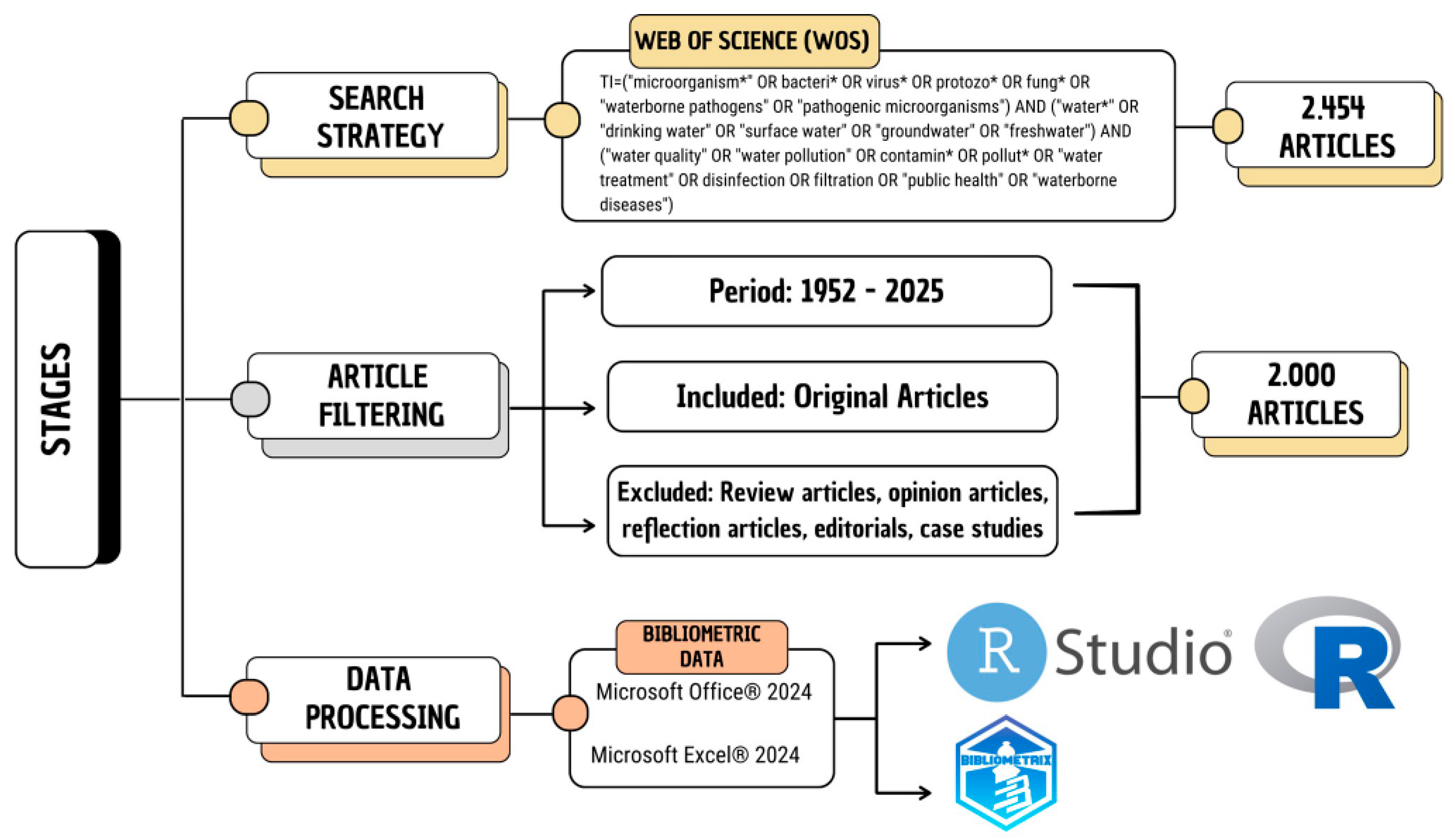
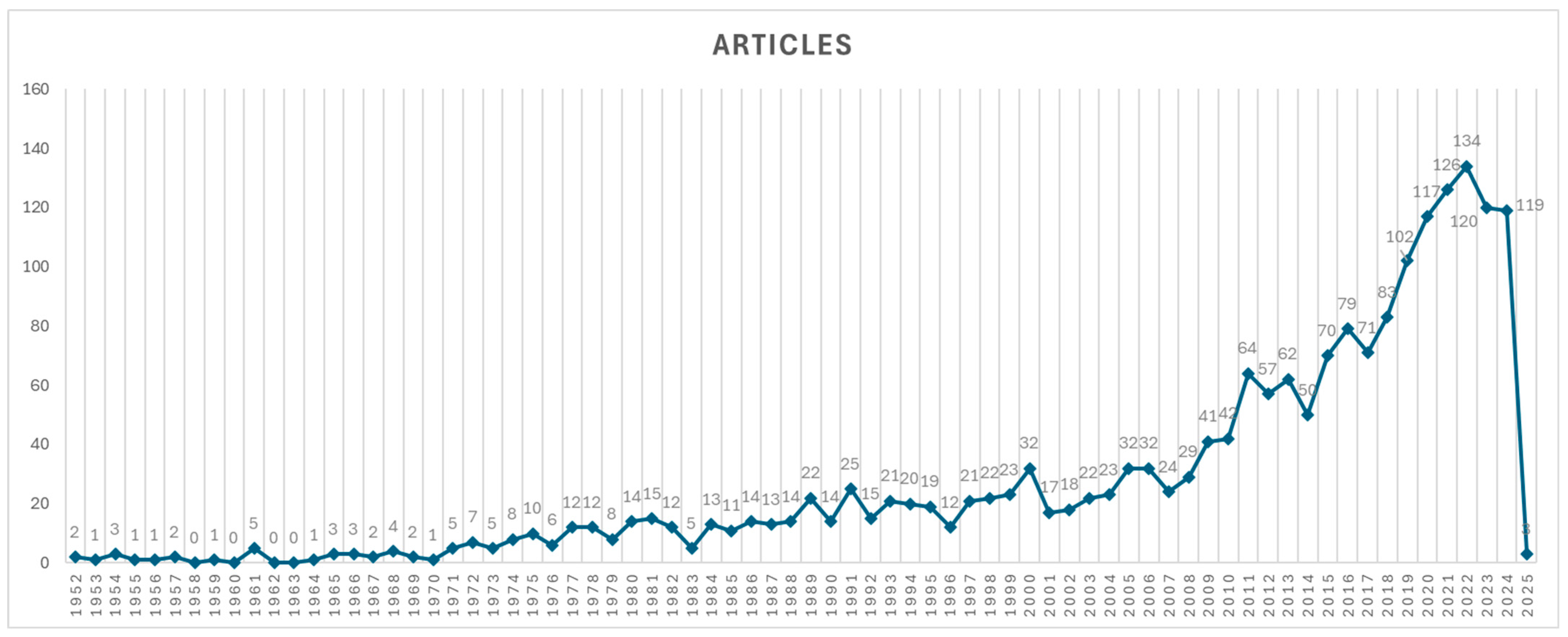
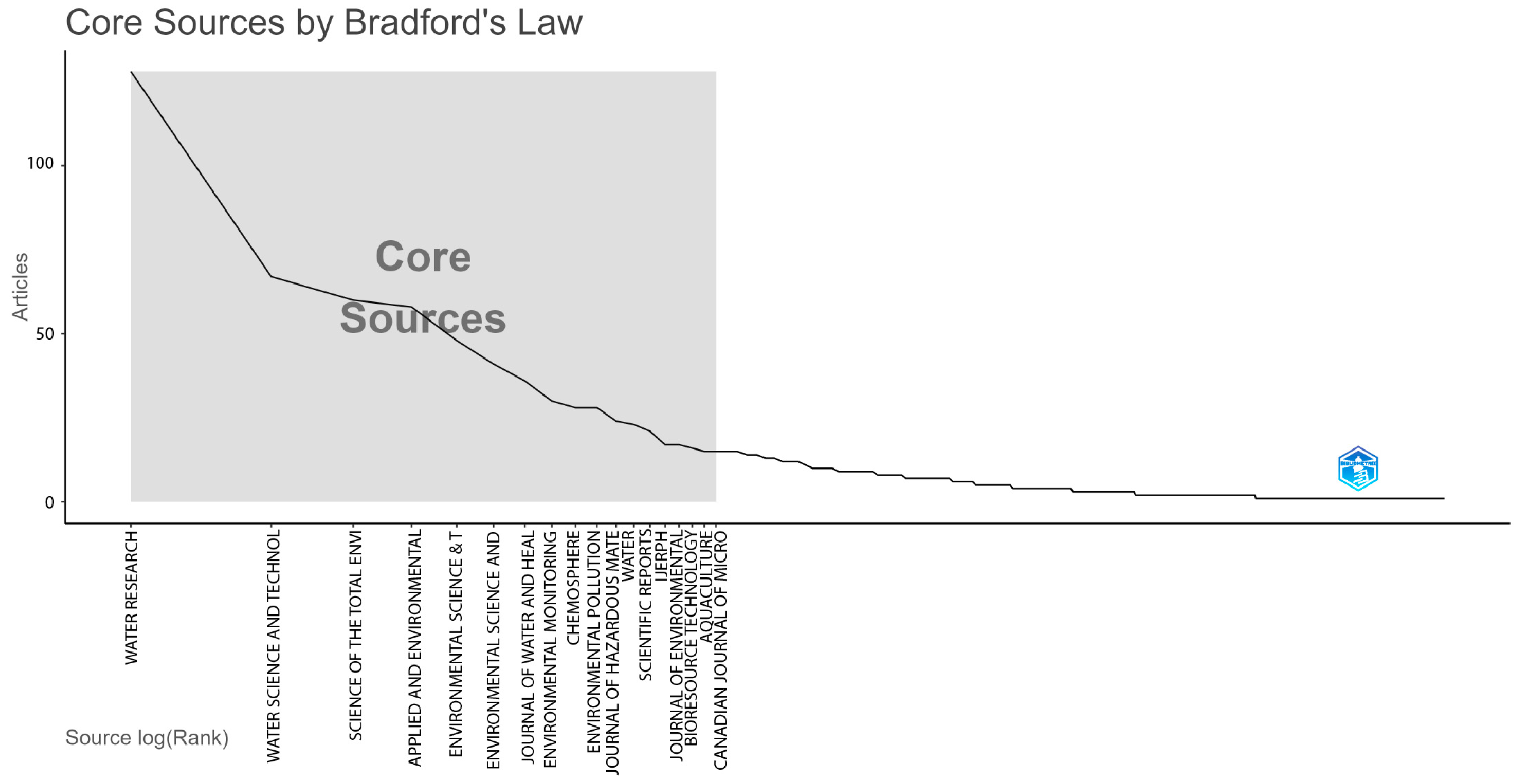


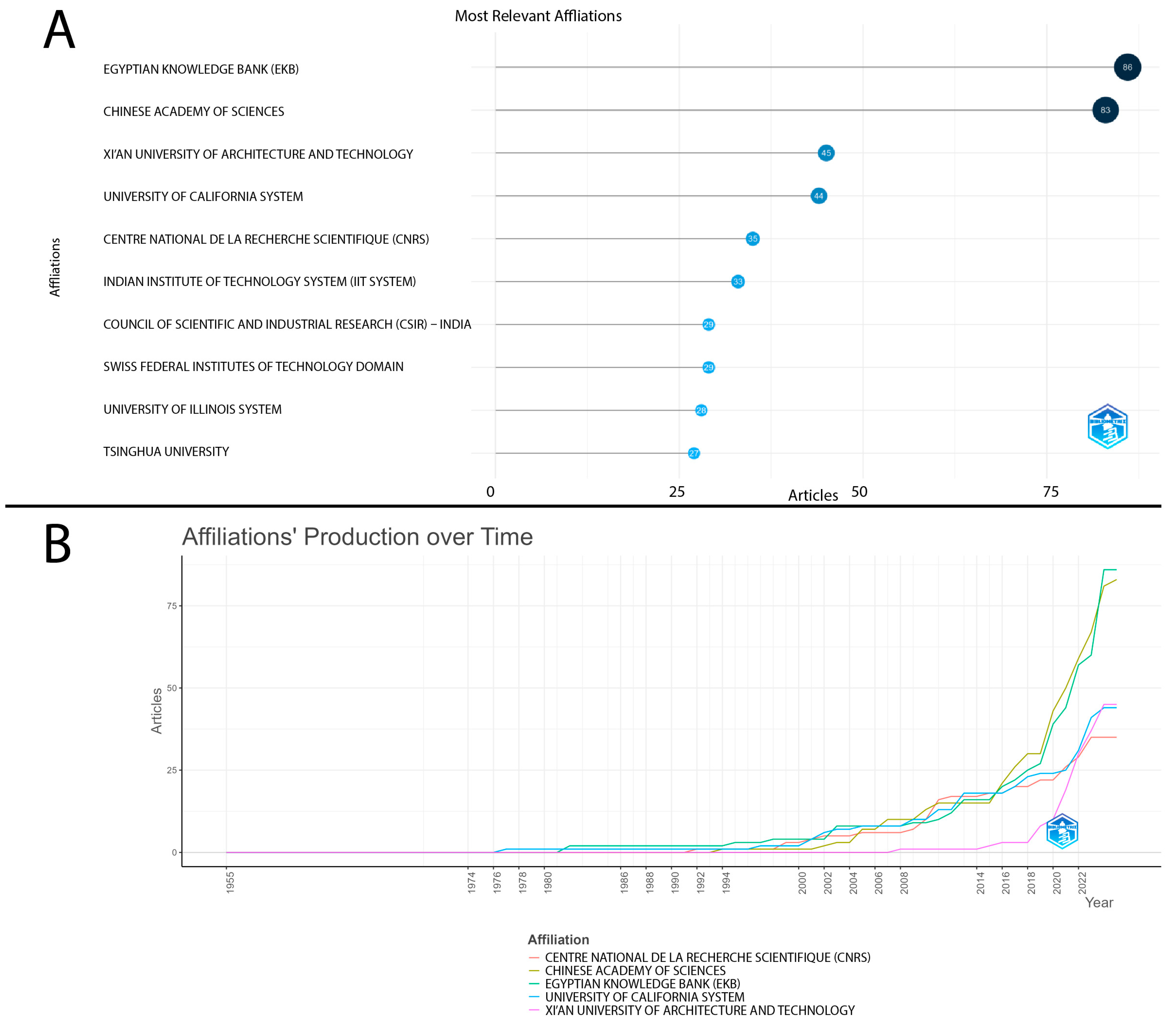

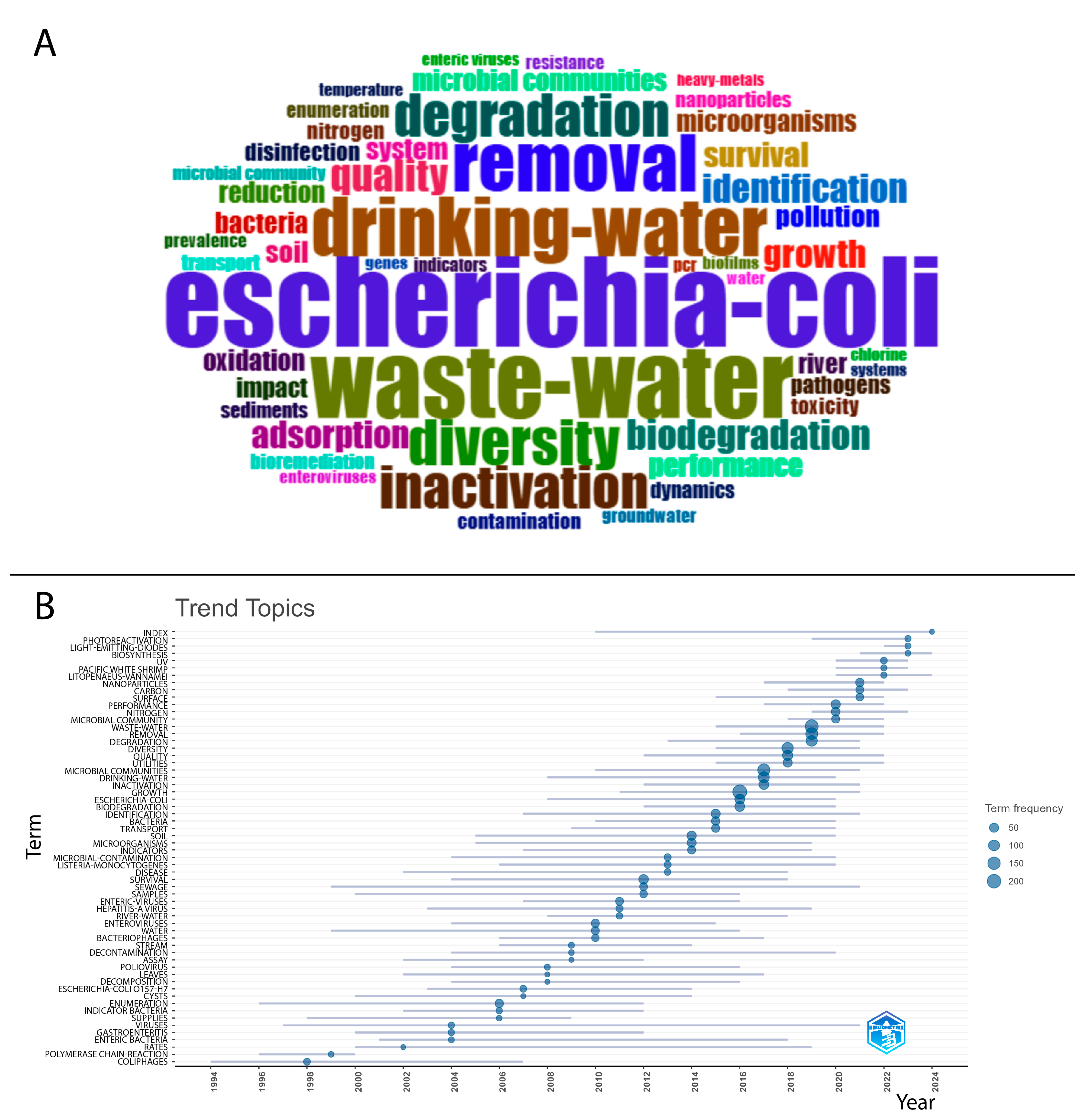

| Rank | Authors (Year), Journal | Title | Total Citations |
|---|---|---|---|
| 1 | Frederik Hammes et al. (2008) [18], Water Res | Flow-cytometric total bacterial cell counts as a descriptive microbiological parameter for drinking water treatment processes | 475 |
| 2 | Chang. Wei et al. (1994) [19], Environ Sci Technol | Bactericidal Activity of TiO2 Photocatalyst in Aqueous Media: Toward a Solar-Assisted Water Disinfection System | 436 |
| 3 | Tanja Barac et al. (2004) [20], Nat Biotechnol | Engineered endophytic bacteria improve phytoremediation of water-soluble, volatile, organic pollutants | 420 |
| 4 | Peter Kämpfer et al. (1991) [21], Microb Ecol | Microbiological characterization of a fuel-oil contaminated site including numerical identification of heterotrophic water and soil bacteria | 408 |
| 5 | Chad W. McKinney et al. (2012) [22], Environ Sci Technol | Ultraviolet Disinfection of Antibiotic Resistant Bacteria and Their Antibiotic Resistance Genes in Water and Wastewater | 396 |
| 6 | Qi Bao et al. (2011) [23], J Colloid Interf Sci | Synthesis and characterization of silver nanoparticle and graphene oxide nanosheet composites as a bactericidal agent for water disinfection | 381 |
| 7 | Theresa A. Dankovich et al. (2011) [24], Environ Sci Technol | Bactericidal Paper Impregnated with Silver Nanoparticles for Point-of-Use Water Treatment | 377 |
| 8 | Ameet J. Pinto (2012) [25], Environ Sci Technol | Bacterial Community Structure in the Drinking Water Microbiome Is Governed by Filtration Processes | 337 |
| 9 | Michael A. Mallin et al. (2000) [26], Ecol Appl | Effect of human development on bacteriological water quality in coastal watersheds | 301 |
| 10 | Darryl H. Dvorak et al. (1992) [27], Biotechnol Bioeng | Treatment of metal-contaminated water using bacterial sulfate reduction: Results from pilot-scale reactors | 286 |
| 11 | P Payment et al. (1993) [28], Appl Environ Microb | Clostridium perfringens and somatic coliphages as indicators of the efficiency of drinking water treatment for viruses and protozoan cysts | 255 |
| 12 | SU HC, et al. (2018) [29] Sci Total Environ | Persistence of antibiotic resistance genes and bacterial community changes in drinking water treatment system: From drinking water source to tap water | 249 |
Disclaimer/Publisher’s Note: The statements, opinions and data contained in all publications are solely those of the individual author(s) and contributor(s) and not of MDPI and/or the editor(s). MDPI and/or the editor(s) disclaim responsibility for any injury to people or property resulting from any ideas, methods, instructions or products referred to in the content. |
© 2025 by the authors. Licensee MDPI, Basel, Switzerland. This article is an open access article distributed under the terms and conditions of the Creative Commons Attribution (CC BY) license (https://creativecommons.org/licenses/by/4.0/).
Share and Cite
Tirado, Z.I.C.; Sayaverde, I.W.D.; Yajahuanca, R.d.S.A.; Aparicio, S.C.; Aliaga, K.M.J.d.; Aparicio, E.G.; Tyrrel, M.A.R.; Fortes Figueiredo, M.d.L.; Borges, J.W.P.; Brito Magalhães, R.d.L.; et al. Global Research Trends on Water Contamination by Microorganisms: A Bibliometric Analysis. Int. J. Environ. Res. Public Health 2025, 22, 1128. https://doi.org/10.3390/ijerph22071128
Tirado ZIC, Sayaverde IWD, Yajahuanca RdSA, Aparicio SC, Aliaga KMJd, Aparicio EG, Tyrrel MAR, Fortes Figueiredo MdL, Borges JWP, Brito Magalhães RdL, et al. Global Research Trends on Water Contamination by Microorganisms: A Bibliometric Analysis. International Journal of Environmental Research and Public Health. 2025; 22(7):1128. https://doi.org/10.3390/ijerph22071128
Chicago/Turabian StyleTirado, Zoila Isabel Cárdenas, Isaías Wilmer Duenas Sayaverde, Rosario del Socorro Avellaneda Yajahuanca, Sdenka Caballero Aparicio, Kelly Myriam Jiménez de Aliaga, Edo Gallegos Aparicio, Maria Antonieta Rubio Tyrrel, Maria do Livramento Fortes Figueiredo, José Wicto Pereira Borges, Rosilane de Lima Brito Magalhães, and et al. 2025. "Global Research Trends on Water Contamination by Microorganisms: A Bibliometric Analysis" International Journal of Environmental Research and Public Health 22, no. 7: 1128. https://doi.org/10.3390/ijerph22071128
APA StyleTirado, Z. I. C., Sayaverde, I. W. D., Yajahuanca, R. d. S. A., Aparicio, S. C., Aliaga, K. M. J. d., Aparicio, E. G., Tyrrel, M. A. R., Fortes Figueiredo, M. d. L., Borges, J. W. P., Brito Magalhães, R. d. L., Andrade, D., Freitas, D. R. J. d., Batista de Carvalho, A. R., & Batista Moura, M. E. (2025). Global Research Trends on Water Contamination by Microorganisms: A Bibliometric Analysis. International Journal of Environmental Research and Public Health, 22(7), 1128. https://doi.org/10.3390/ijerph22071128






